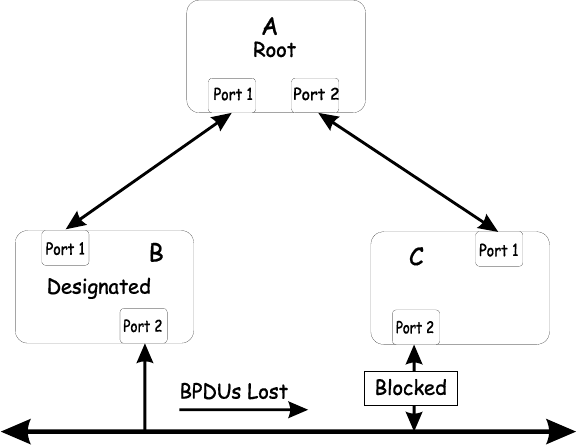
In this example, port 2 on B can receive but not transmit packets. Port 2 on C should be in the blocking state, but since it can
no longer receive BPDUs from port 2 on B, it will transition to the forwarding state. If the failure exists at boot, STP will not
converge and rebooting the bridges will have no effect. (Note: Rebooting would help temporarily in the previous example).
This type of failure is difficult to detect because the Link-state LEDs for Ethernet links rely on the transmit side of the cable to
detect a link. If a unidirectional failure on a link is suspected, it is usually required to go to the console or other management
software and look at the packets received and transmitted for the port. A unidirectional port will have many packets
transmitted but none received, or vice versa, for example.
Packet Corruption
Packet corruption can lead to the same type of failure. If a link is experiencing a high rate of physical errors, a large number of
consecutive BPDUs can be dropped and a port in the blocking state would transition to the forwarding state. The blocking port
would have to have the BPDUs dropped for 50 seconds (at the default settings) and a single BPDU would reset the timer. If
the MAX AGE is set too low, this time is reduced.
Resource Errors
The DES-3250TG Layer 2 switch performs its switching and routing functions primarily in hardware, using specialized
ASICs. STP is implemented in software and is thus reliant upon the speed of the CPU and other factors to converge. If the
CPU is over-utilized, it is possible that BPDUs may not be sent in a timely fashion. STP is generally not very CPU intensive
and is given priority over other processes, so this type of error is rare.
It can be seen that very low values for the MAX AGE and the FORWARD DELAY can result in an unstable spanning tree.
The loss of BPDUs can lead to data loops. The diameter of the network can also cause problems. The default values for STP
give a maximum network diameter of about seven. This means that two switches in the network cannot be more than seven
hops apart. Part of this diameter restriction is the BPDU age field. As BPDUs are propagated from the root bridge to the
leaves of the spanning tree, each bridge increments the age field. When this field is beyond the maximum age, the packet is
discarded. For large diameter networks, STP convergence can be very slow.
Identifying a Data Loop
Broadcast storms have a very similar effect on the network to data loops, but broadcast storm controls in modern switches
have (along with subnetting and other network practices) have been very effective in controlling broadcast storms. The best
way to determine if a data loop exists is to capture traffic on a saturated link and check if similar packets are seen multiple
times.
Generally, if all the users of a given domain are having trouble connecting to the network at the same time, a data loop can be
suspected. The port utilization data in the switch’s console will give unusually high values in this case.


















